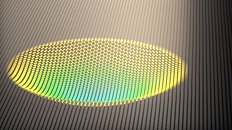Monday, November 28th 2016
Monitors with 1000 ppi: Scientists researching Graphene to develop 'Mechanical Pixels'
At the Delft University of Technology in the Netherlands, scientists were hard at work researching how to produce mechanical Graphene sensors. Working with membranes measuring only two atoms thick, there are 13 micrometer-sized round air filled cavities in a silicon surface (silicon oxide) that are covered by double-layered Graphene. Upon observing these samples, the scientists noticed that the colors of the membranes differed. When the pressure within the cavities varied, the air 'bubbles' became concave or convex, changing how light refracted through them and created different colors.
At first this disappointed the scientists, as it became apparent that the small bubbles were not homogeneous enough to build a sensor. However they quickly noticed that the effect showed promise for an entirely different path of research - the Mechanical Pixel. The scientists speculate that screens built using this technology could eventually lead to much more flexible, durable and energy efficient panels than current LED technology allows. They do however caution that this research is very much in stages of infancy, it remains to be seen whether this mechanization of Graphene could conclude in screens of comparable quality or be scaled up to mass production. Bear in mind the samples that are currently being worked with would produce a panel with a pixel density north of 1,000 DPI. An explanation for mechanical color pixels can be found in this Vimeo video.
Source:
TU Deft
At first this disappointed the scientists, as it became apparent that the small bubbles were not homogeneous enough to build a sensor. However they quickly noticed that the effect showed promise for an entirely different path of research - the Mechanical Pixel. The scientists speculate that screens built using this technology could eventually lead to much more flexible, durable and energy efficient panels than current LED technology allows. They do however caution that this research is very much in stages of infancy, it remains to be seen whether this mechanization of Graphene could conclude in screens of comparable quality or be scaled up to mass production. Bear in mind the samples that are currently being worked with would produce a panel with a pixel density north of 1,000 DPI. An explanation for mechanical color pixels can be found in this Vimeo video.

8 Comments on Monitors with 1000 ppi: Scientists researching Graphene to develop 'Mechanical Pixels'
www.techpowerup.com/forums/threads/scientists-create-colour-changing-graphene-bubbles-for-flexible-displays.228157/
english.etnews.com/20150710200002
Don't forget, that at this point it is a purely theoretical thing, not nearing the market at least for another 5 years. Pretty sure by then we'll find even more uses for it.
Meanwhile, scratch your head on today's Experia Z5 w/ 4k screen (806ppi). I'm still confused as to which market it was created for... but apparently next year we will have a lot more of that.
www.theverge.com/circuitbreaker/2016/10/7/13197252/sharp-vr-4k-display-1000-ppi